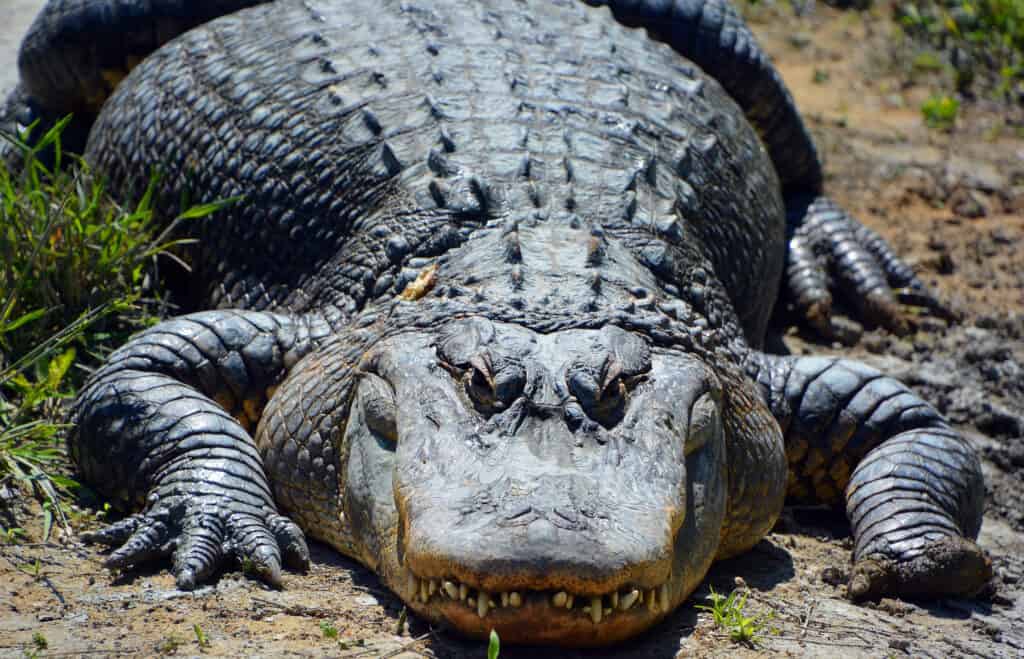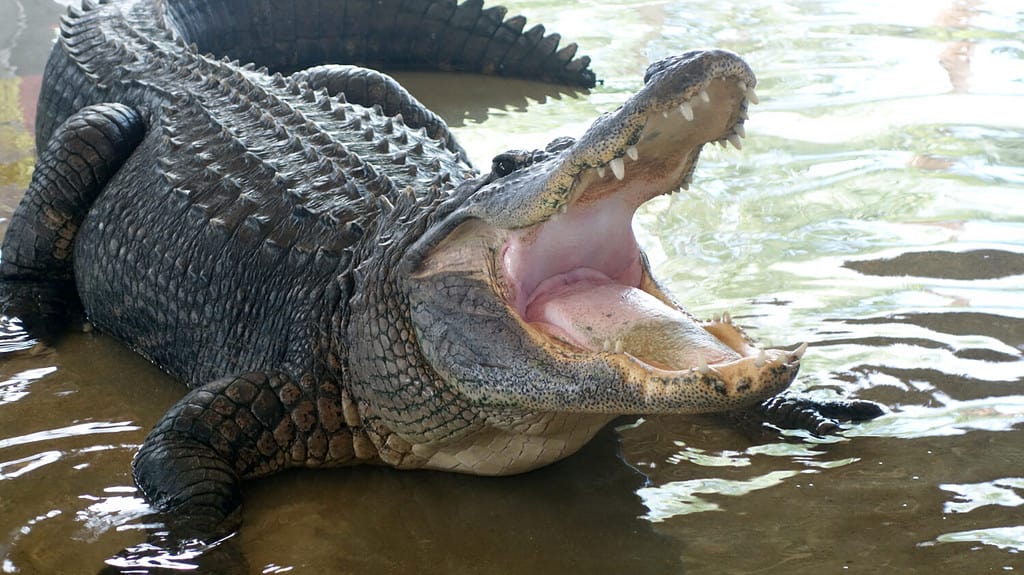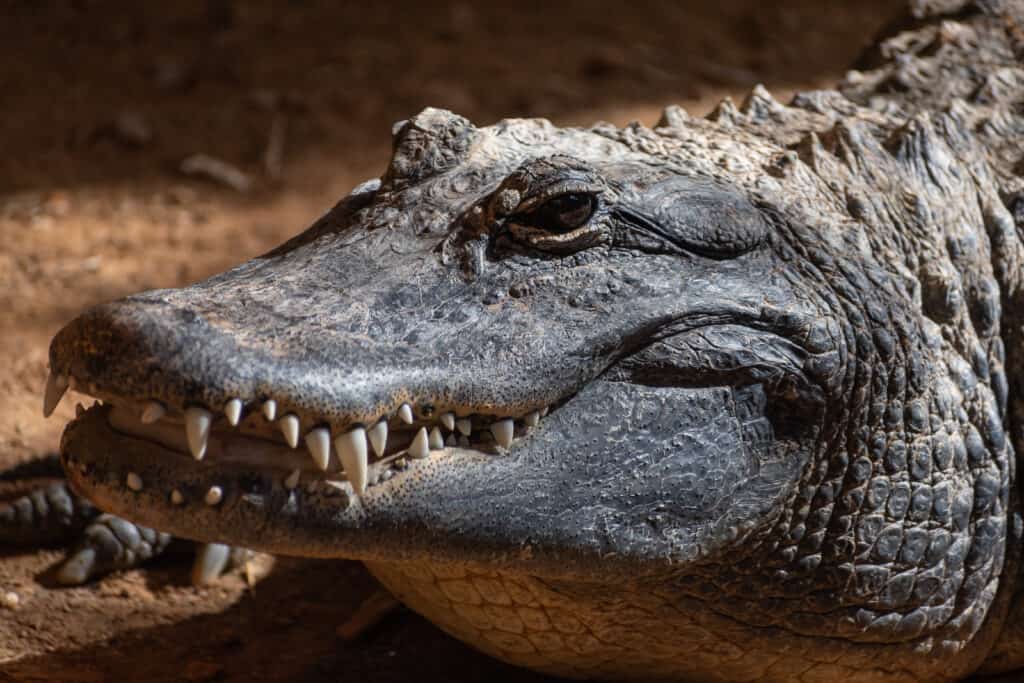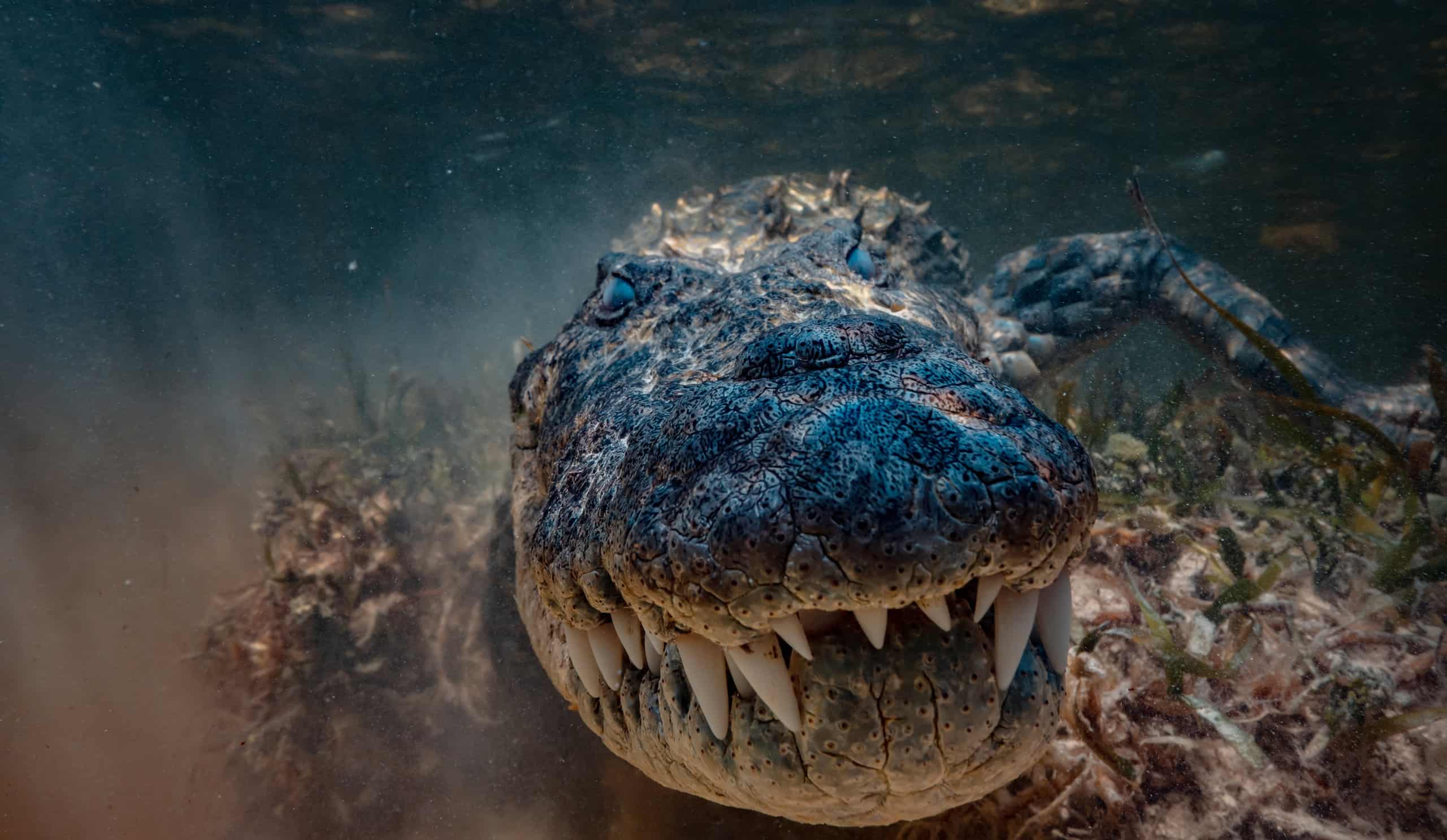How can you tell a female alligator apart from a male? The answer isn’t as easy as telling apart alligators vs. crocodiles. For starters, alligators exhibit minimal sexual dimorphism. In other words, the physical characteristics between males and females aren’t easy to spot at first glance. Thankfully, a few subtle clues can help separate these beasts. Read on to learn the key differences between male vs. female alligators.
Comparing a Male and Female Alligator

In adulthood, male alligators have broad distinct snouts in comparison to the narrow-headed female.
©meunierd/Shutterstock.com
Male alligators generally are larger and longer than females, although exceptions can occur. They also have more prominent facial features, especially as adults. Female alligators have less broad snouts. The small snout is helpful for catching small prey, which they need for their hatchlings. Their bodies are also comparably narrower, allowing them to navigate through dense vegetation.
Key Differences Between a Male and Female Alligator
The key differences between a male vs. female alligator are size, reproductive systems, nesting and offspring care, growth rate, and communication. They have a blend of similarities and differences when it comes to feeding habits, hunting strategies, and life expectancy.
1. Male vs. Female Alligator: Size

Male alligators are usually larger than female alligators, sometimes reaching lengths of 14 feet or longer.
©iStock.com/Joe Pearl Photography
When you read about the biggest alligators ever recorded, you’ll notice they’re all males. Male alligators are larger than females, sometimes by a lot and sometimes by just a few inches. The average size for females is around 8 feet, with the average male coming in around 11 feet. Sometimes males can grow to exceptional lengths, like the 14-foot one found in Florida by alligator hunter Robert Ammerman. The massive male gator weighed 654 pounds.
2. Male vs. Female Alligator: Reproductive Systems

In terms of reproductive organs, it’s not easy to spot the differences between a male vs. female alligator.
©Robert Gregory Griffeth/Shutterstock.com
Male alligators have a dark red slit between their hind legs, serving as their vent. Female alligators also have a vent, but it’s half the size and has a light pink or white color. Diane Kelly from the University of Massachusetts is a scientist who specializes in studying animal penises. Her research led to the discovery that male alligators don’t experience any type of inflation or deflation stage. Instead, they remain permanently erect, all because of collagen.
3. Male vs. Female Alligator: Nesting and Offspring Care

Mother alligators stay with their young for up to 2 years.
©Marc Pletcher/Shutterstock.com
If you see an alligator defending a nest, it’s a female. Females are fiercely protective of their eggs and hatchlings, protecting them from predators and intruders. They use aggressive displays, including loud hisses and bluff charges, to prevent potential threats. Females can spend up to two years with their young.
During June or July, the female builds a nest using marsh vegetation, creating a large mound reaching several tall and around 10 feet in diameter. The decaying vegetation in the nest generates heat, maintaining the necessary incubation temperature for the eggs. The temperature inside the nest determines the sex of the hatchlings.
4. Male vs. Female Alligator: Social Behaviors and Communication

Male alligators communicate with deep throaty bellows, grunts, groans, and head slaps.
©Ernie Hounshell/Shutterstock.com
Male alligators bellow, grunt, groan, and slap their heads, all as a form of communication. Females can bellow, but not nearly as deep as males. The deep bellows of a male convey their body size to other alligators. This helps competing males assess competitors and avoid unfavorable contests for mates and breeding areas.
During mating season, male alligators also perform head slaps. The unmistakable sound can carry long distances across the water, attracting females. Male alligators also employ a variety of grunts and groans to display their desire to mate with a female. Finally, both male and female baby alligators grunt when they’re cold, hungry, or scared.
5. Male vs. Female Alligator: Feeding Habits and Hunting Strategies

Alligators are ambush predators who prey on animals ranging in size from fish to deer.
©iStock.com/CoinUp
The biggest difference between male vs. female alligators regarding feeding habits is how much they need. Surprisingly, alligators don’t eat a ton of food all the time. During the summer, a large male alligator may consume food only once or twice a week, while a smaller female may eat even less frequently.
Male and female alligators hunt similarly; they ambush, drown, and consume their prey. A specialized throat adaptation known as a glottis enables them to catch prey fully submerged in water. Larger alligators feel more comfortable targeting large prey like deer, whereas smaller gators prefer to focus on waterfowl, turtles, and fish.
6. Male vs. Female Alligator: Life Expectancy and Aging

Alligators continue growing their entire lives, with males and females slowing growth at different stages.
©iStock.com/cturtletrax
Alligators continue to grow throughout their lives, but their main growth or primary growth spurt only lasts so long. This is the time when the alligator will gain the most length and weight. The males’ main growth stops around age 20, and females stop at 45. On average, alligators typically live 30 to 50 years, but there are records of some individuals living over 80 years.
Male and female alligators also develop at different rates, with males being much faster to develop. When hatching, alligators are typically about 9 inches long. Until reaching a length of 36 inches, both male and female alligators grow at the same pace. Then after this point, females grow slower than males. This leads to sexual dimorphism, where adult males are larger than females.
Final Thoughts: Male vs. Female Alligators
Today we learned about the key differences between male and female alligators. When it comes to size, we learned that males take the crown; they’re much larger and longer than their female counterparts. While females typically average around 8 feet in length, males can reach an impressive 11 feet or more.
Finally, another key difference to remember is how they grow. Both male and female alligators continue to grow throughout their lives, but their primary growth drops off at different ages. Males, who grow to be the biggest, gain inches at a fast pace. Their speedy development means they can mostly stop growing around 20 years of age. Females grow at a slower pace, with primary growth halting around 45 years of age.
Thank you for reading! Have some feedback for us? Contact the AZ Animals editorial team.








